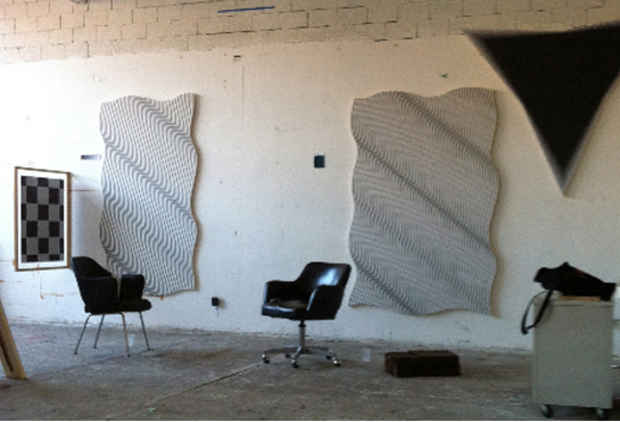Philippe Decrauzat Exhibition
Elizabeth Dee

This event has ended.
Elizabeth Dee announces the second solo-exhibition at the galley by Philippe Decrauzat. Two new series of paintings are presented in tandem in the main gallery and his 16mm flicker film, Screen-o-Scope is projected in the viewing room. A pair of new drawings are also on exhibit in the front room.
Primary concerns to Decrauzat’s practice are reiterated by the joint presentation of two painting series, Vertical Wave and Untitled(Fragment). Working in the context of the optical line, Decrauzat references graphs of force and duration (as in the graphic representation of cosmic phenomena) as well as art historical tendencies of radical painting. Vertical Wave describes an undulation as a crossing between two and three dimensions, real and perceived motion. Untitled (Fragment) is a continuation of Decrauzat’s polysemous mediation of the moiré pattern, specifically citing the cover illustration of a 1963 issue of The Scientific American depicting this effect. These “paintings” are isolated graphical forms drawn from the overall rhythmic whole given by the initial image. In conjunction, these two series interrupt the viewer’s anticipation of spatial linearity with the introduction of the diagonal.
Fluidly repurposing significant visual and historical references, Decrauzat expands on the meaning his sources have for new ways of seeing. The 16mm film, Screen-o-Scope, takes a moment from Akira Kurosawa’s Rashomon (1950) where flickering sunlight is partially obstructed by branches and foliage; a technical device Kurosawa employed to transition between scenes. Similar to his past appropriations from cinema (Alfred Hitchcock’s The Birds, George Lucas’ THX 1138…) Decrauzat identifies this structural turn, extracts and interrogates it through a different presentation, implicating the viewer in the process. He reminds us that perception is not contingent on a knowledge of history but that there is always a historicity attached to perception.3
With Screen-o-Scope, Philippe Decrauzat evokes the history of experimental cinema, calling to mind the work of Tony Conrad, Brion Gysin, and the modernist polymath, Frederick Kiesler. Kiesler’s Film Guild Cinema, a moviehouse built in 1929 in Greenwich Village, featured a giant, iris-like apparatus which was responsive to the shifting visual qualities of the projected films, aspiring to a total engagement of the viewer’s attention. Decrauzat links these investigations, maintaining the original sources while interrogating them optically. If appropriation is the condition of our existence, then Decrauzat questions our attention to this condition.
Media
Schedule
from May 02, 2012 to June 23, 2012